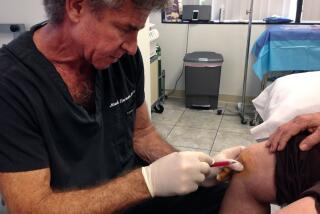O.C. Doctors, Labs Lose Key Ruling on Joint Ventures : * Medicine: U.S. panel decides that profit-making relationships between physicians and testing facilities violate federal law. A crackdown is under way.
- Share via
Federal officials won an important legal victory Wednesday in an Orange County case likely to fuel the government’s escalating crackdown on questionable financial relationships among doctors, hospitals and medical testing laboratories.
The ruling by an administrative law panel of the U.S. Department of Health and Human Services holds that profit-making joint ventures between doctors and test labs violate federal law even if there is only an indirect relationship between the number of patients a doctor refers and the amount he or she earns from shares in the lab.
Any financial “inducement” to refer patients could put doctors and their investment partners afoul of the law, the three-member panel said in remanding a case brought against the medical director and managing partners of the Santa Ana-based Hanlester Network.
Critics said the ruling in the case of three physician-owned laboratories run by Hanlester fails to provide a clear standard for what the government would consider a legal business relationship.
Specialists in health law said the decision opens the door to prosecution of doctors and business partners in any joint venture where the doctors’ patients contribute to profits. Thousands of these ventures have sprung up across the country over the past decade, with doctors investing in clinical labs, medical imaging centers and even hospitals to which they admit patients.
The Hanlester case--the first administrative prosecution under 1987 amendments to the Medicare and Medicaid fraud statutes--has been watched closely as an indication of how broadly the government would interpret its powers to declare such ventures illegal.
It has major implications for other health-care-related “kickback” cases around the country, government officials say. In one such case in Orange County, two radiologists are suing Anaheim General Hospital, saying it terminated their contract because the doctors refused to pay a $181,000 “marketing fee.” The radiologists say the fee was nothing but a kickback for patient referrals, a contention the hospital denies.
Federal health authorities say many of these financial arrangements jeopardize patient care by encouraging unnecessary tests and procedures that, in turn, drive up health-care costs.
“Our experience has been that health-care providers come up with a whole variety of schemes to disguise payments for referrals,” said Thomas S. Crane, the prosecutor in the Hanlester case. These payments, Crane said, may be called “consultants’ fees, space rental, billing services (or) marketing fees,” but under the Hanlester panel’s reasoning, they are all illegal.
David Langness, spokesman for the Hospital Council of Southern California, said the Hanlester ruling “muddies” rather than clarifies what doctors and hospitals understand to be legal commercial ventures.
“On one hand, we are happy to see that some of the more dubious of these kickback arrangements are being decided upon,” Langness said. “But on the other, we need to know the rules for all of us to feel comfortable.”
Also critical was Dr. C. John Tupper, past president of the American Medical Assn. He said it was “cynical” of the government to presume that physician investments in medical service business were always motivated by profit, and said many rural areas will lose services if local doctors are barred from setting up labs or similar medical services.
Patric Hooper, lawyer for the Hanlester defendants, said the panel’s 60-page ruling was so lacking in specifics that “anyone who takes a doctor out to lunch, I suppose, could be prosecuted.”
But Crane, the government’s lawyer, said the ruling is in line with so-called safe-harbor regulations, issued last summer by the Department of Health and Human Services to guide these controversial business relationships. One of the regulations, for example, says the ventures are legal if 60% of the investors are people who cannot refer patients, or if 60% of a lab’s business comes from non-owners.
More than 200 California doctors at one time owned limited partnerships in the three laboratories run by the Hanlester network: Omni Physicians Clinical Laboratory in Pasadena, Pacific Physicians Clinical Laboratory in Santa Ana, and Placer Physicians Clinical Laboratory in Sacramento. All the labs have ceased operation, according to Hooper.
For a minimum investment of $1,500, the doctors were promised a 50% rate of return with the understanding that their patients would be the main customer base.
Richard P. Kusserow, the federal agency’s inspector general, had charged that dividend payments to physician-investors in the California labs amounted to illegal kickbacks because the money encouraged doctors to send patients to their own labs.
The ruling Wednesday upheld Kusserow’s assertions and voided an earlier decision by federal administrative law Judge Steven Kessel. He must now decide, in light of Wednesday’s ruling, whether to bar the labs and several of their principals from participation in the Medicare and Medicaid programs. This is the government’s harshest sanction under the law, and amounts to a financial coup de grace for any business that depends upon health insurance reimbursement.
Kessel had ruled that the defendants should not be kicked out of these government insurance programs because nothing in their partnership agreements specifically linked the amount of money their investments would return to the number of patients they referred.
But the three-member appellate panel said such specific linkage was unnecessary.
“The statute focuses on the substance, rather than the form, of any transaction or relationship,” the panel wrote. “Moreover, the absence of a guarantee of referrals does not mean that referrals, once made, are any less ‘in return for’ remuneration, where there is an intentional connection between the referral and the remuneration.”
More to Read
Inside the business of entertainment
The Wide Shot brings you news, analysis and insights on everything from streaming wars to production — and what it all means for the future.
You may occasionally receive promotional content from the Los Angeles Times.










